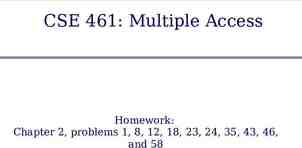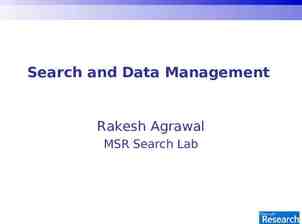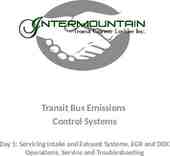Modeling and Analysis of State-ofthe-art VM-based Cloud Management
40 Slides1.81 MB
Modeling and Analysis of State-ofthe-art VM-based Cloud Management Platforms Saif U. K. Malik, Samee U. Khan, Senior Member, IEEE, Surdarshan K. Srinivansan, Member, IEEE IEEE TRANSACTIONS ON CLOUD COMPUTING (2013) 報告者: 計財 15 100071018 韋自鴻 計財 15 100071020 楊佑濬 1
Introduction 2
What is Cloud Computing? 3
Cloud Computing structure User Level User-Level Middleware Core Middleware Application Social Computing, Enterprise, ISV, Programming language Web 2.0 介面 , Mashups, Workflows, Control Qos Neqotiation, Ddmission Control, Pricing, SLA Management, Metering Virtualization VM, VM management and Deployment System Level 4
現有的雲端運算服務 Windows Google Amazon Yahoo . 5
Type of Cloud Computing Industry 6
Features of cloud computing Virtualization Large scale High reliability pay-as-you-go High Scalability High versatility Low Cost 7
Cloud Computing Industry Infrastructure as a Service IaaS Delivers computer infrastructure such as virtualization, storage, and networking that offers incremental scalability. infrastructure stack: Full OS access Firewalls Routers Load balancing 8
Cloud Computing Industry Examples Flexiscale AWS: EC2 (Amazon Elastic Compute Cloud) IaaS 9
Cloud Computing Industry Platform as a Service Provide a platform for system administrators and developers to build, test and deploy custom applications Expensive cost management system Popular services PaaS IaaS Storage Database Scalability 10
Cloud Computing Industry Examples PaaS Google App Engine AWS: S3 (Simple Storage Service) Microsoft Azure IaaS 11
Cloud Computing Industry SaaS PaaS IaaS Software as a Service Do not manage hardware and software Simple operation (browser) Pay per use Instant Scalability Security Reliability 12
Cloud Computing Industry SaaS PaaS IaaS Examples Google Docs CRM Financial Planning Human Resources Word processing Salesforce.com 13
Comparison table Service Property Amazon EC2 Google App Engine Microsoft Azure Yahoo Hadoop 架構 Iaas/Paas Paas Paas Software 服務型態 Compute/ Storage Web application Web and nonweb Software 管理技術 OS on Xen hypervisor Application container OS through Fabric controller Map / Reduce Architecture 使用者介面 EC2 Command-line tools Web-based Administration console Windows Azure portal Command line and web APIs yes yes yes yes 收費 yes maybe yes no 程式語言 AMI (Amazon Python .NET framework Java, Machine Image) 14
Open Source IaaS the most widely used open source hypervisors in the recent IaaS providers: (a) Xen (b) KVM three open source state-of-the-art VM-based cloud management platforms : (a) Eucalyptus (b) Open Nebula (c) Nimbus 15
Eucalyptus The less level of customization that makes it appropriate for a private company, where one needs a cloud for own use and wants to avoid mistakes from the users. The best feature is compatible with Amazon EC2. 16
Open Nebula the highest level of customizability that allow users to switch almost every component from the underlying Virtual Machine Monitor (VMM) to the frontend. Open Nebula is suitable in an experimental environment, where one wants to explore every component and crack new results from the computational perspective. 17
Nimbus Nimbus also provides a high level of customization. However, the major portion of customization in Nimbus is available to the administrator. Nimbus is more suitable for an environment, where one is less interested in technical details of the systems, but requires a broad level of customization, such as cooperative scientific communities. 18
Modeling and Analysis of the systems In this study, we made an effort to diminish the level of abstraction through detailed modeling and formal analysis of the platforms being discussed. We have used High Level Petri Nets (HLPN) and Z language for the modeling and analysis of the systems. 19
High Level Petri Nets (HLPN) HLPN is used to: (a) simulate the systems and (b) provide mathematical representation, to analyze the behavior and structural properties of the system. The model of the systems will help analyze: (1) the interconnection of the components and processes . (2) the fine-grain details of the flow of information amongst the processes. (3) how the information is processed. 20
Z3 solver First, we performed the automated verification of the models by Checking technique using Satisfiability Modulo Theories Library (SMTLib) and Z3 solver. Then, Z3 solver is used to check either the model satisfies the properties or not. Second, to verify the feasibility of the models as the number of VMs scales and verify the correctness. The results generated reveals that the models are working correctly. 21
Modeling and Analysis of VMbased Cloud Management Platforms 22
Eucalyptus Architecture 23
HLPN of Eucalyptus 24
Conclusion for Eucalyptus Supports corporate enterprise computing setting The administration space is separated from the user space. Easy to deploy on top of the existing resource. Suitable for experimentation because of having modular design open source in nature. Users are only allowed to use the system through web interface 25
Open Nebula Architecture 26
HLPN of Open Nebula 27
Conclusion for Open Nebula The level of customization available of Open Nebula is suitable for researchers who wish to combine cloud system with other technologies. The centralized nature makes administration easier Higher level of customization makes it ideal for research Users need to have some technical expertise Users can make a mistake while providing config for a VM 28
Nimbus Architecture 29
HLPN of Nimbus 30
Conclusion for Nimbus Provides different resources leases to different users as a mean of scheduling The flexibility and customization available to perform experiment Workspace tools can operate with Xen hypervisor and as well as KVM. 31
Verification of Models Using SMTLib and Z3 Solver 32
Kripke structure and Computational Tree 33
34
35
36
37
38
CONCLUSIONS AND FUTURE WORK 39
CONCLUSIONS AND FUTURE WORK In future, we will analyze, model, and verify some other cloud management platforms, such as OpenStack, oVirt, and ECP. Moreover, we will also perform a detailed feasibility analysis of the aforesaid platforms under different SLA constraints. 40













































